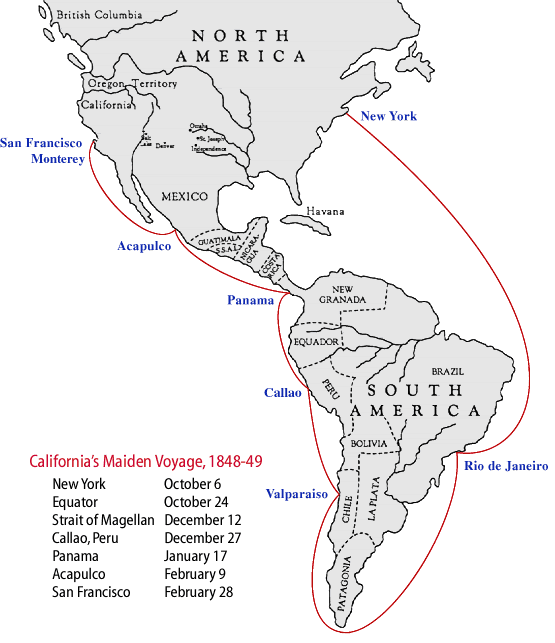 1848 Route of the "California" When gold was discovered at Sutter's Mill in California in 1848, it set off the great Gold Rush. While many people went overland across the country, many others chose to go "around the horn". This meant boarding a ship at New York City, Boston, or another eastern port and heading south, south, south. The ships kept going until they reached Cape Horn, the tip of South America. Making their way around it, they then headed north for San Francisco. In 1849, over 700 ships made this voyage of 13,00 miles, usually in 6-8 months, stopping at ports along the way to resupply. While it was by far the longest route and was very expensive (around $300 per person), there were many advantages. People could set off in the winter when the overland routes were blocked. They could bring along far more baggage and cargo. And they didn't have to worry about buying their own supplies or facing any of the many hazards along the way. It is easy to see why ships were so popular. There were many disadvantages as well, though. Ships were at the mercy of the wind and waves. Sitting motionless for days waiting for fair weather was not uncommon. Longer periods at sea meant running low on food which meant disease and scurvy. The overcrowded conditions led to illness spreading very quickly. And the trip around Cape Horn was by far the most dangerous part. Ships could spend weeks fighting hurricanes, snowstorms, and frigid winds before they rounded it, and many never made it through. When they had made it around, their problems still weren't over! Contrary winds could blow a ship far off course, sometimes as far as the Hawaiian Islands. And once they made it up to California, they could sit for days waiting for winds to blow them into the San Francisco bay. One ship, the Apollo, waited for two weeks until the winds changed! In the end, though, most ships made it through. It wasn't the easiest way, but it was the only way to haul large amounts of supplies and heavy machinery to the gold mines and boom towns. This is your chance to see what it was like to go "around the horn". The map at the top of the page is the basis for the game board. It shows the route of the steamship "California", which had the U.S. Mail contract in 1848. It had a very interesting journey on the way to the San Francisco and is the basis for much of the game play. More information about it can be found here. The "California" stopped at 6 ports along the way, but this was more than most ships. It made the extra stops because it needed fuel, food and water, and picked up passengers. Some ships made one or two stops. The game uses 3 stops, at Rio de Janeiro, Valparaiso, and Panama. The game board is broken into 4 pieces so it can be printed out larger. Cardstock is a good idea, but not essential. You will also need tokens to use as the ships and a normal 6-sided die. The event cards should also be printed on cardstock if possible.
|